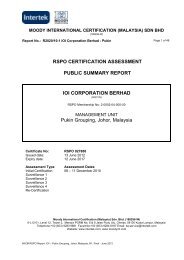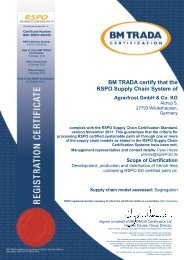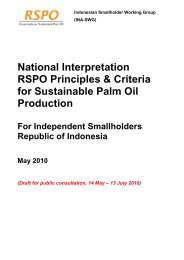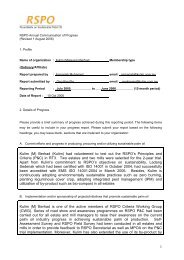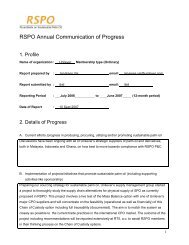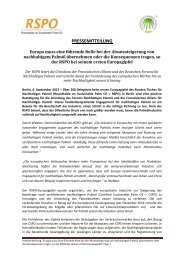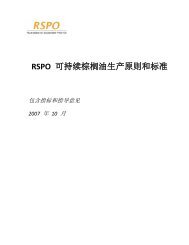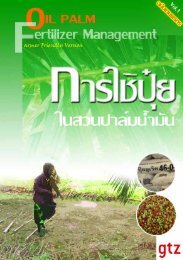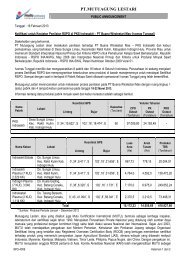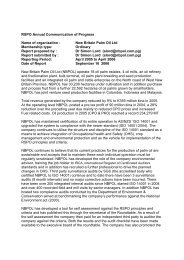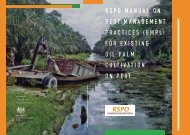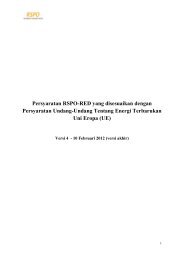RSPO CERTIFICATION ASSESSMENT PUBLIC SUMMARY REPORT
RSPO CERTIFICATION ASSESSMENT PUBLIC SUMMARY REPORT
RSPO CERTIFICATION ASSESSMENT PUBLIC SUMMARY REPORT
Create successful ePaper yourself
Turn your PDF publications into a flip-book with our unique Google optimized e-Paper software.
Criterion 5.2<br />
The status of rare, threatened or endangered species and high conservation value habitats, if<br />
any, that exist in the estate or that could be affected by estate or mill management, shall be<br />
identified and their conservation taken into account in management plans and operations.<br />
PTTN had a HCV assessment done on 7-10 August 2010 at Normark Estate and on 13-20 August<br />
2010 for Langga Payung Estate and Paya Baung Estate by HCV Team from` Environmental<br />
Department that consists of <strong>RSPO</strong> approved HCV assessors, such as Norman FM, Nugroho Wahyu,<br />
Bambang Setyaji. which has identified HCV area that cover of total area 483.98 ha. The HCV’s areas<br />
are recognized with HCV’s 1.1, 1.2 and 4.1.. The peer review has been conducted by independent<br />
consultant, Ir. Siswo, M.Si Public consultation for HCV has been done on 3-4 Novemebr 2010. The<br />
HCV’s area was identified with sufficient signboards that contain warnings of what people should not<br />
do to the protected HCVs such as prohibition to practice land burning. hunt protected animsal, illegal<br />
fishing that can damaged the river/ body water (poisoning, using exploding materials, illegal logging<br />
and disturb protected flora. Identification of HCV’s was recorded in” List of Protected Species”of<br />
operating procedure SOP/PBNE/KPHCV, which identified of 6 aves, 2 mammals and 1 reptil and 2<br />
protected flora according to CITES, IUCN or national regulation PP 7 Year 1999. Some sites of Bunga<br />
bangkai (Amorphopalus sp) were found during visit and protected by bamboo fences. There is HCV<br />
management plan and monitoring program developed by Environmental Department, while HCV<br />
monitoring is conducted by trained HCV officers in each estates.<br />
Compliance Status : Full.<br />
Criterion 5.3<br />
Waste is reduced, recycled, re-used and disposed of in an environmentally and socially<br />
responsible manner<br />
PTTN has identified all waste and pollutions sources in the mill and estates and listed them in<br />
accordance with its related procedure that classified the wastes as office wastes, household wastes,<br />
mill wastes, workshop wastes and pesticide wastes. The records of actual wastes in the mill and<br />
estates are documented properly in Wastes Management Plan (5.3.1). Suitable methods have been<br />
established to minimize the production of wastes and to minimize their environmental impacts. EFB is<br />
used to mulch young palms in the field near mill in Langga Payung Estate Division II, IV, V and VI with<br />
the dosage 30 t/ha, liquid wastes treated as in Instalasi Pengolah Air Limbah /IPAL (waste water<br />
treatment) to reduce their BOD and COD, with their pH monitored to the requisite standards.<br />
Analyses of POME for BOD, COD and pH are done regularly to ensure the parameters meet the<br />
standards, the last report in Semester II 2010 ( 5.3.2 and 5.3.4) showing compliance. POME is used<br />
as land application in the field near mill in Langga Payung Estate instead of dispatching into rivers or<br />
body waters.<br />
The hazardous waste were collected by licensed contractor and the records of hazardous waste<br />
manifest were well maintained. PTTN has a plan to return the waste container to the vendor and the<br />
mutual agreement has been signed. (5.3.3).<br />
Compliance Status : Full.<br />
Criterion 5.4<br />
Efficiency of energy use and use of renewable energy is maximized<br />
PTTN has a renewable energy program in which it continually strives to improve energy efficiency and<br />
use more renewable vis-à-vis fossil fuels. The mill have energy use monitoring records in kilowatt<br />
hours per tonne of palm product, and has program to increase energy efficiency by reducing fossil fuel<br />
consumption, since the generator set is only used as backup to generate electricity when the main<br />
turbine is down. Regular maintenance of mill engines ( e.g: boiler, sterilizer, BPV, Steam separator,<br />
Motor Compressor, turbine) and motor vehicles also contribute to increase energy efficiency rate.<br />
Compliance Status : Full.<br />
Public Summary Report PT.Tapian Nadenggan –Langga Payung Mill Page 29





